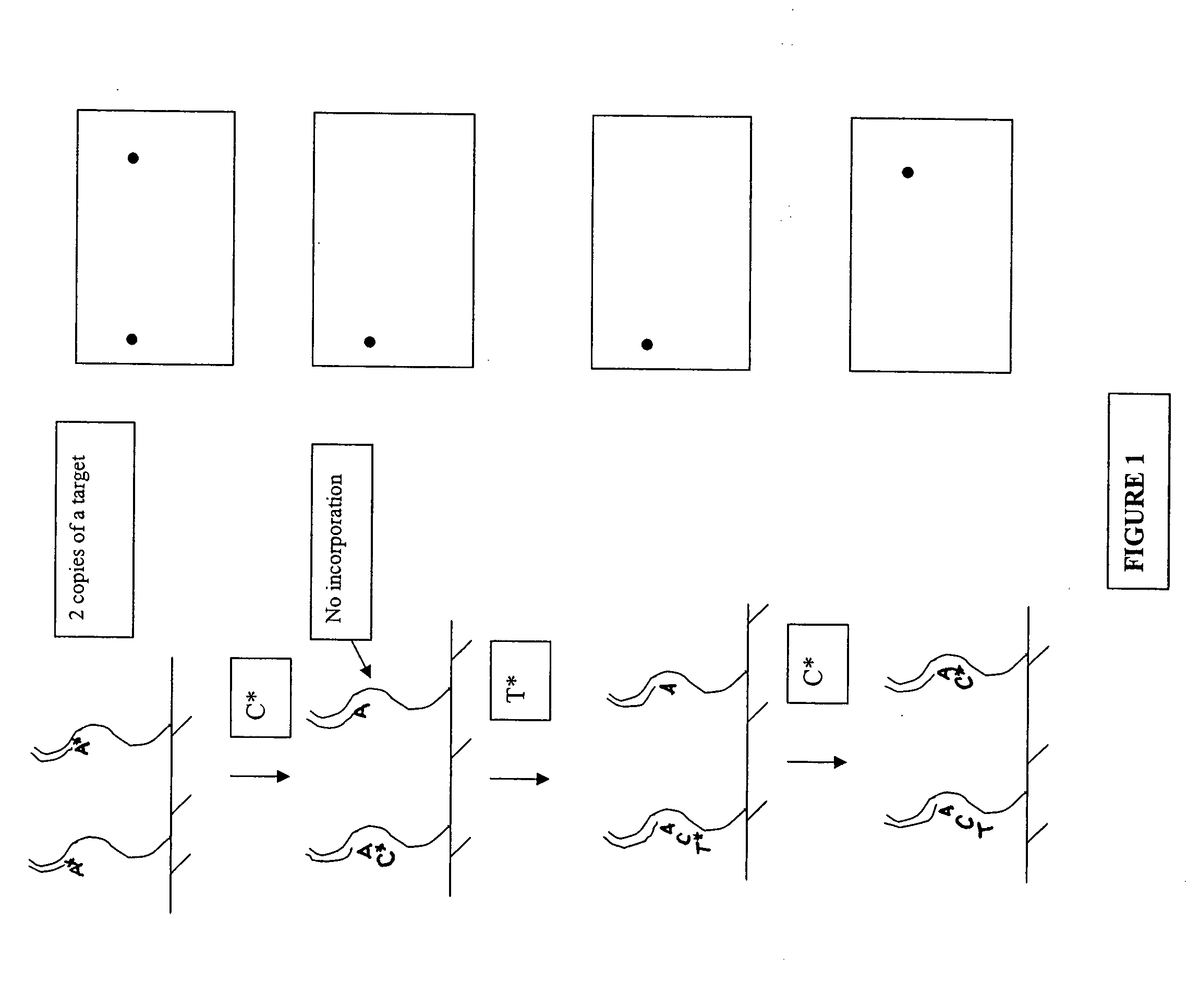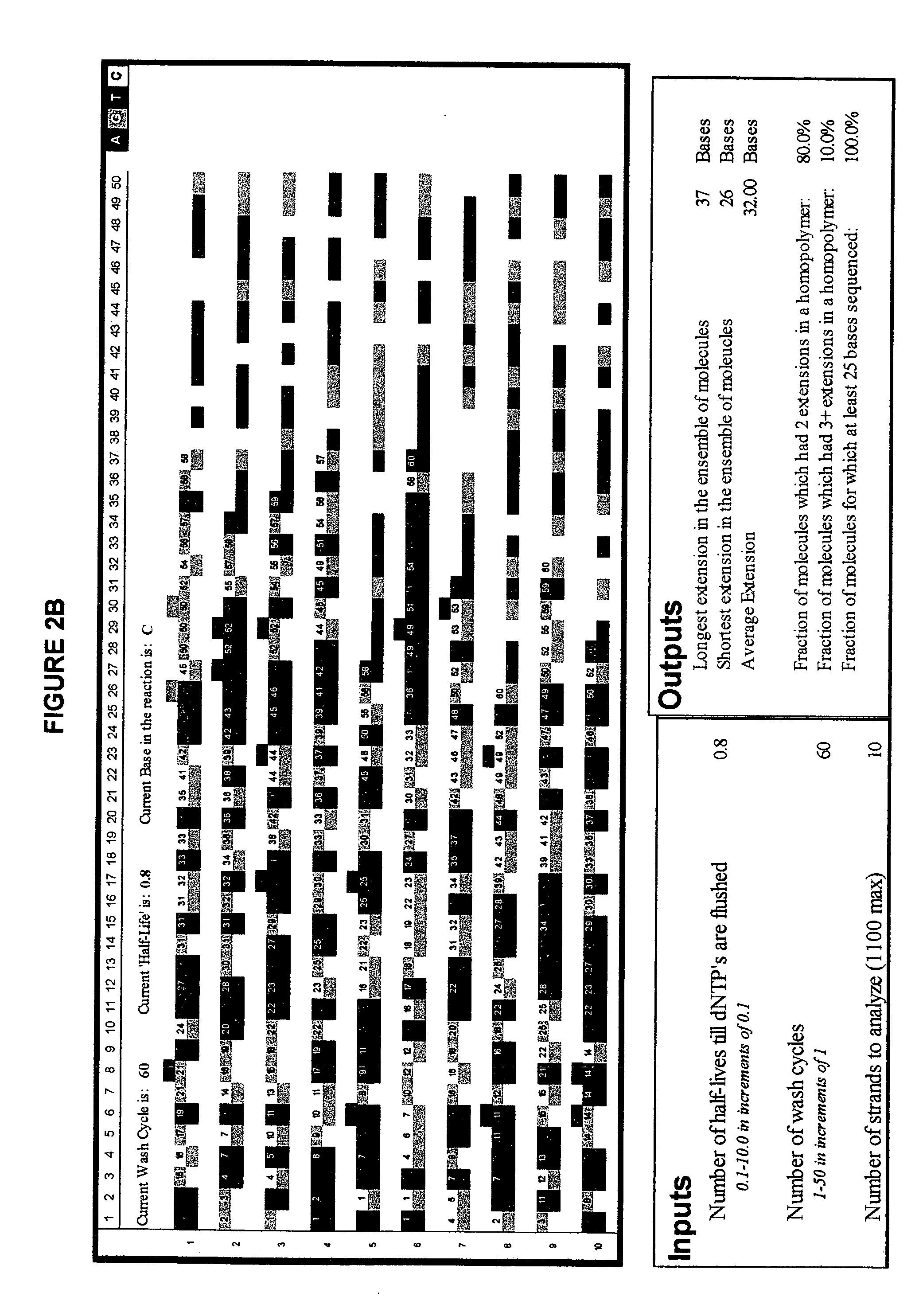Short cycle methods for sequencing polynucleotides
a polynucleotide and short cycle technology, applied in the field of short cycle methods for sequencing polynucleotides, can solve the problems of ineffective detection of single nucleotide differences between samples, inconvenient comparative whole genome sequencing, and bulk techniques, so as to improve the resolution and reliability of single molecule sequencing, accurately resolving a sequence, and high throughput single molecule sequencing
- Summary
- Abstract
- Description
- Claims
- Application Information
AI Technical Summary
Benefits of technology
Problems solved by technology
Method used
Image
Examples
example 1
[0077] Primers are synthesized from nucleoside triphosphates by known automated oligonucleotide synthetic techniques, e.g., via standard phosphoramidite technology utilizing a nucleic acid synthesizer, such as the ABI3700 (Applied Biosystems, Foster City, Calif.). The oligonucleotides are prepared as duplexes with a complementary strand, however, only the 5′ terminus of the oligonucleotide proper (and not its complement) is biotinylated.
Ligation of Oligonucleotides and Target Polynucleotides
[0078] Double stranded target nucleic acids are blunt-end ligated to the oligonucleotides in solution using, for example, T4 ligase. The single strand having a 5′ biotinylated terminus of the oligonucleotide duplex permits the blunt-end ligation on only on end of the duplex. In a preferred embodiment, the solution-phase reaction is performed in the presence of an excess amount of oligonucleotide to prohibit the formation of concantamers and circular ligation products of the target nucleic acid...
example 2
[0088]FIG. 2 illustrates the advantage of short-cycle sequencing with respect to avoiding long homopolymer reads. FIG. 2a illustrates a simulated analysis of 10 target polynucleotides using non-short-cycle sequencing (Example 2a), whereas FIG. 2b illustrates a simulated analysis of the same number of target polynucleotides using short-cycle sequencing (Example 2b).
[0089] The simulations were performed as follows: an Excel spreadsheet was opened and “Customize . . . ” selected from the “Tools” menu of the Excel toolbar. The “Commands” tab was selected and, after scrolling down, “Macros” was clicked. The “smiley face” that appeared in the right panel was dragged to the toolbars on top of the spreadsheet. The “Customize” box was closed and the “smiley face” clicked once. From the list of subroutines that appeared, “ThisWorkbook.Main_Line.” was selected. The program was run by clicking again on the “smiley face.” A copy of the source code for the Excel simulation is provided below.
[00...
example 3
[0109]FIG. 2 illustrates yet another simulated analysis of a number of target polynucleotides using short-cycle sequencing. The simulation was run using the program described in Examples 2a and 2b but using a larger number of target polynucleotides.
[0110] That is, in this simulation, the input values used were a cycle period of 0.8 half-lives, 60 repeats of the cycle, and 200 target polynucleotide strands. FIG. 2 illustrates the results obtained. Homopolymers stretches which occurred in the same simulated complementary strand are highlighted in magenta wherever nucleotides of the same base type were incorporated in a row, and in cyan wherever more than two nucleotides of the same base type were incorporated in a row.
[0111] The output values obtained were 48 incorporations in the longest extended complementary strand, 20 in the shortest, and 32.00 as the average number of incorporations for the 200 simulatedly extended complementary strands.
[0112] Further, the percentage of growin...
PUM
| Property | Measurement | Unit |
|---|---|---|
| Fraction | aaaaa | aaaaa |
| Fraction | aaaaa | aaaaa |
| Time | aaaaa | aaaaa |
Abstract
Description
Claims
Application Information
 Login to View More
Login to View More - R&D
- Intellectual Property
- Life Sciences
- Materials
- Tech Scout
- Unparalleled Data Quality
- Higher Quality Content
- 60% Fewer Hallucinations
Browse by: Latest US Patents, China's latest patents, Technical Efficacy Thesaurus, Application Domain, Technology Topic, Popular Technical Reports.
© 2025 PatSnap. All rights reserved.Legal|Privacy policy|Modern Slavery Act Transparency Statement|Sitemap|About US| Contact US: help@patsnap.com



